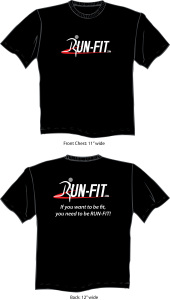I haven’t spent a lot of time writing my blog lately. I often wonder how many people read blogs anyway given how most people can’t wait to tell me how busy they are. If people are so busy, who’s got time to read other people’s blogs? LOL.
One of the reasons I haven’t been writing my blog is because I’ve been busy (there’s that word!) promoting my new Run-Fit Specialist certification. It offers 1.9 CECs from NASM and I just submitted it to ACE for CEC approval. If you or any co-workers train runners, I highly recommend becoming a Run-Fit Specialist. Along with all the course materials, you even get a free dri-fit T-shirt!
I also recently signed a contract for another book deal, which is the subject of this blog post. I’m so happy about this book. It’s called The Inner Runner. At least that’s my title. I hope the publisher doesn’t change it because it means a lot to me. Since my writing efforts of late are concentrated on this book, I thought for this blog post I’d share the first draft of the book’s preface. Please leave a comment below to let me know what you think.
Preface to The Inner Runner
If the fields of physical education and exercise science were ever asked to agree on a corporate slogan, a front runner undoubtedly would be a line stolen from the ancient Greeks: “Mens sana in corpore sano”—a sound mind in a sound body. Indeed, many runners seem to support this sentiment with a zeal that borders on the fanatical.
For me, the fanatics started 31 years ago, with a race once around the track in sixth grade. Little did I know how much it would change my life. I became a runner, and there was no turning back. Actually, it started before that. It was fifth grade, during the Presidential Physical Fitness Tests. Remember those? I ran the 50-yard dash in 6.7 seconds and the 600-yard run in 2:01. It was then that I discovered that I had some talent. It was also then that I discovered the freedom that running confers.
It was not much later, while competing in track in middle school, that I also discovered that running can be physically uncomfortable. I competed in the 400 meters in middle school. If you’ve ever run 400 meters as fast as you can, you know it hurts. You feel like you have lead in your legs as you come off the final turn. But it’s in those fatiguing moments that you learn about yourself. Any race longer than 400 meters has those moments. When it hurts, do you back off to make it hurt less, or do you push through the discomfort to the finish line? Few other times in our lives are we faced with such a decisive moment. Every time you go to the starting line of a race, you know you’re going to be faced with that. It causes some anxiety, which explains why runners take multiple trips to the bathroom in the moments before a race.
In nearly every way, including my relationship with the bathroom, my life has been defined by running. Not running means not being me. It’s remarkable that millions of other runners feel the same way. Why are so many people drawn to running? Why does running have so much impact on me and on so many others? Why do people cry when they cross the finish line of a marathon? What is it about running that empowers so many people? And how can runners harness that power to create a more meaningful life? The Inner Runner addresses these questions, and a whole lot more.
Most people are unaware of this whole life effect of running. Running has taught me how to succeed, how to fail, how to win, and how to lose. It has taught me discipline. It has taught me devotion. It has taught me how to strive for the things I want. It has taught me to be patient. It has taught me that I don’t always get what I want. It can teach you those things, too.
The Inner Runner is not about how to get faster or run a marathon in 20 weeks; there are many books to cover that. Rather, this book takes a holistic view of running, examining how running affects every part of our lives and how all of the parts are intimately interconnected to each other and to the whole person. It explores what it means to be a runner and how the simple act of putting one foot in front of the other helps you become a better person and provides a path to a better, more successful life. The Inner Runner is as much about life as it is about running.
One of the things I hope you’ll learn from this book is that you don’t become a runner and then run. You run and run and run and then begin to understand what it means to be a runner. The Inner Runner is about becoming a runner, becoming a better runner and, through running, becoming more creative, more productive, more imaginative, more empowered, more healthful, and becoming a better you.


7 Responses to Inner Runner